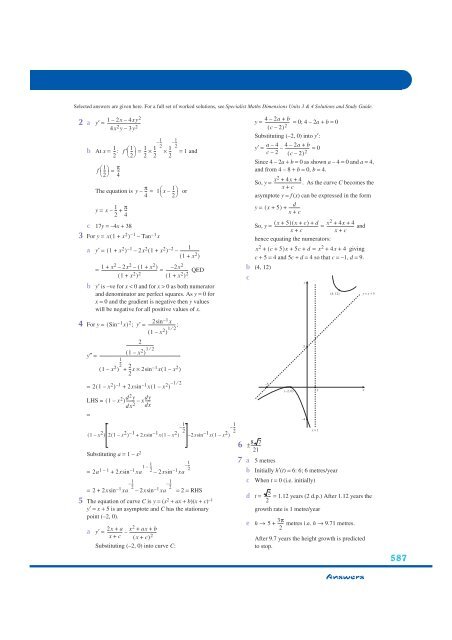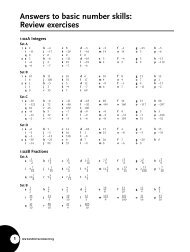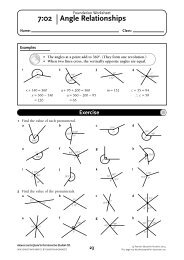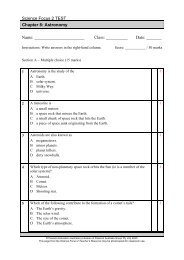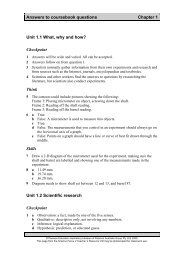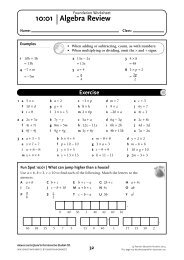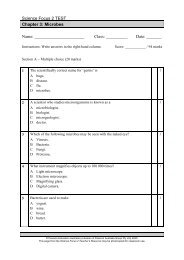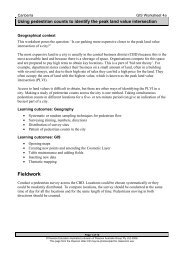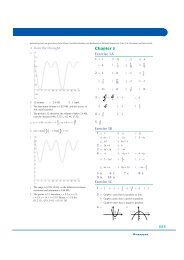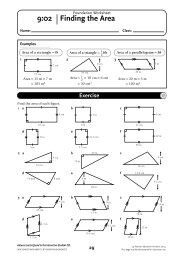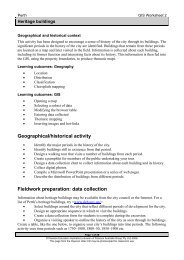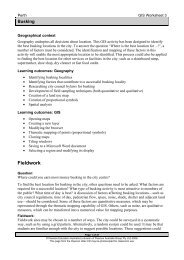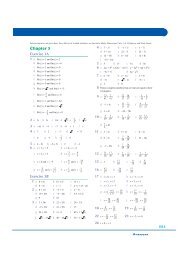575 Answers Chapter 4
575 Answers Chapter 4
575 Answers Chapter 4
You also want an ePaper? Increase the reach of your titles
YUMPU automatically turns print PDFs into web optimized ePapers that Google loves.
Selected answers are given here. For a full set of worked solutions, see Specialist Maths Dimensions Units 3 & 4 Solutions and Study Guide.1 – 2x – 4xy2 a y′ = --------------------------------24x 2 y – 3y 21b At x = --: f ′ 1 = = 1 and2 ⎝ ⎛ 2 -- ⎠⎞ 1–--1–--11 2 1 2-- × -- × --2 2 21f -- =⎝ ⎛ 2⎠⎞ π--4πThe equation is y – -- = 1⎛1x – -- ⎞ or4 ⎝ 2⎠1 πy = x – -- + --2 4c 17y = –4x + 383 For y = x( 1 + x 2 ) – 1 – Tan– 1 xa y′ = ( 1 + x 2 ) – 1 2x 2 ( 1 + x 2 ) – 2 1–– -------------------( 1 + x 2 )1 + x= 2 – 2x 2 – ( 1 + x 2 ) –2x------------------------------------------------------- = QED( 1 + x 2 ) 2 ---------------------2( 1 + x 2 ) 2b y′ is –ve for x < 0 and for x > 0 as both numeratorand denominator are perfect squares. As y = 0 forx = 0 and the gradient is negative then y valueswill be negative for all positive values of x.4 For y = ( Sin – 1x) 2 2sin; y′ =– 1 x---------------------------( 1 – x 2 ) 1 ⁄ 2 ;2---------------------------( 1 – xy″ =2 ) 1 ⁄ 2-------------------------------------------------------------------------------1--1 x 2 2 2( – ) + --x × 2sin – 1 x( 1 – x 2 )2= 21 ( – x 2 ) – 1 + 2xsin– 1 x( 1 – x 2 ) – 1 ⁄ 2LHS = ( 1 – x 2 ) d2 y--------dx 2 – x-----dydx=1–--( 1 – x 2 ) 21 ( – x 2 ) – 1 2xsin – 1 x( 1 – x 2 2+ ) – 2xsin 1Substituting a = 1 – x 2= 2a 1 – 1 2xsin– 1 xa 1 1– --–--12 2xsin – 1 2+– xa11–--–--= 2 2xsin – 1 2xa 2xsin – 1 2+– xa = 2 = RHS5 The equation of curve C is y = (x 2 + ax + b)(x + c) –1y′ = x + 5 is an asymptote and C has the stationarypoint (–2, 0).2x + a xa y′ = --------------2 + ax + b– --------------------------x + c ( x + c) 2Substituting (–2, 0) into curve C:– x( 1 – x 2 )1–--24 – 2a + by = ------------------------ = 0; 4 – 2a + b = 0( c – 2) 2Substituting (–2, 0) into y′:a – 4 4 – 2a + by′ = ----------- – ------------------------ = 0c – 2 ( c – 2) 2Since 4 – 2a + b = 0 as shown a – 4 = 0 and a = 4,and from 4 – 8 + b = 0, b = 4.So, y = -------------------------- x 2 + 4x + 4As the curve C becomes thex + c.asymptote y = f (x) can be expressed in the formdy = ( x + 5)+ ----------- x + c( x + 5) ( x + c) + d xSo, y = ------------------------------------------- = 2 + 4x + 4-------------------------- andx + cx + chence equating the numerators:x 2 + ( c + 5)x + 5c+ d = x 2 + 4x + 4 givingc + 5 = 4 and 5c + d = 4 so that c = –1, d = 9.b (4, 12)c–5(–2, 0)8 76 ±---------217 a 5 metresb Initially h′(t) = 6: 6; 6 metres/yearc When t = 0 (i.e. initially)y5–45d t = ------ = 1.12 years (2 d.p.) After 1.12 years the2growth rate is 1 metre/year3πe h → 5 + ----- metres i.e. h → 9.71 metres.2After 9.7 years the height growth is predictedto stop.1x = 1(4, 12)<strong>Answers</strong>y = x + 5x587


